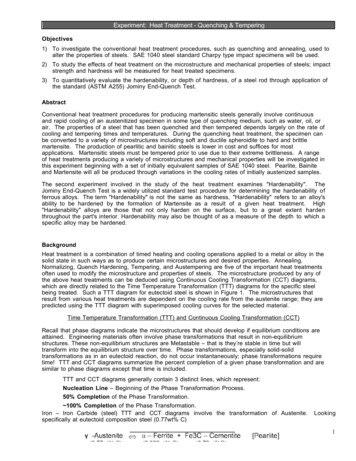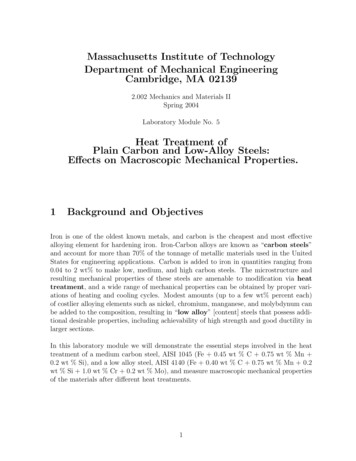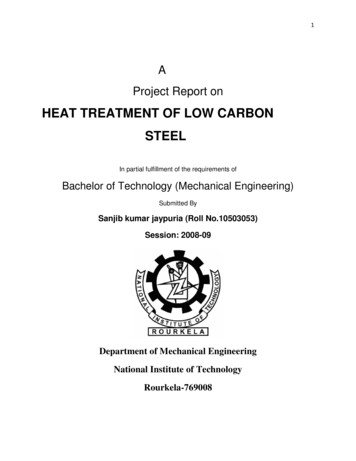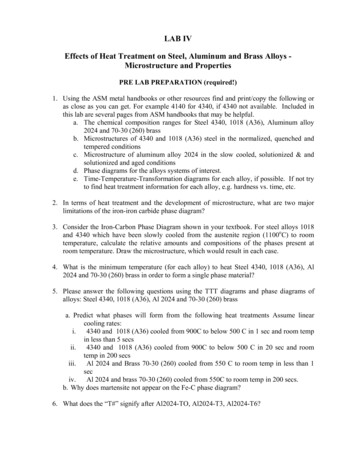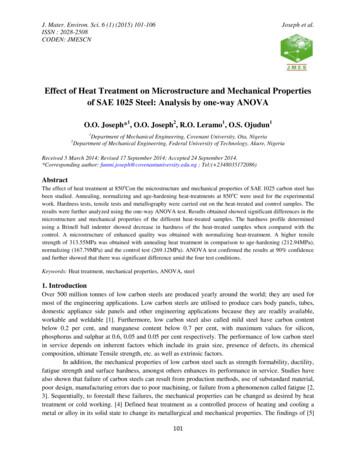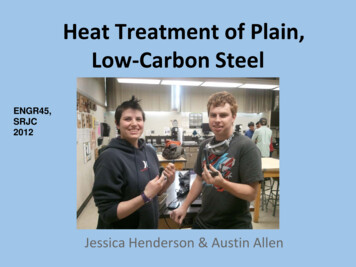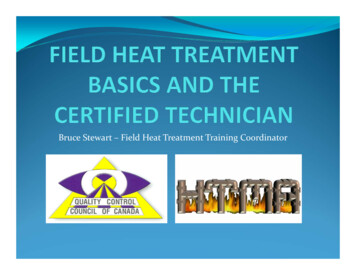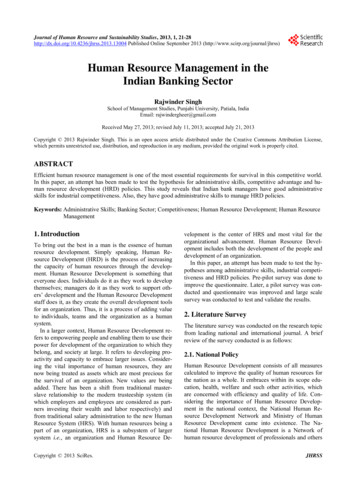
Transcription
HEAT TREATMENT
Heat Treatment process of controlled heating and cooling ofmetals Alter their physical and mechanicalproperties without changing the product shape sometimes takes place inadvertently due tomanufacturing processes that either heat orcool the metal such as welding or forming.
Heat TreatmentDEFINATION:A combination of heating & cooling operationtimed & applied to a metal or alloy in thesolid state in a way that will produce desiredproperties.- Metal Hand Book (ASM)
Heat Treatment Often associated with increasing the strengthof material Can also be used to obtain certainmanufacturing objectives like– To improve machining & formability,– To restore ductility– To recover grain size etc.– Known as Process Heat Treatment
Heat Treatment Heat treatment done for one of the followingobjective:– Hardening.– Softening.– Property modification.
Heat Treatment Hardening heat treatments particularlysuitable for Steels– Many phase transformation involved evenin plain carbon steel and low-alloy steel. Other type of heat treatments equallyapplicable to ferrous & non-ferrous
Hardening Heat Treatment Hardening of steels is done to increase thestrength and wear properties. Hardening (Quenching followed byTempering) is intended for improving themechanical properties of steel. Generally increases hardness at the cost oftoughness
Hardening Heat Treatment Pre-requisites for hardening is sufficientcarbon and/or alloy content.– Sufficient Carbon - Direct hardening/Casehardening.– Otherwise- Case hardening
Hardening Heat TreatmentCommon Hardening Heat Treatments: Direct Hardening– Heating Quenching Tempering Austempering Martempering Case Hardening– Case carburizing
Hardening Heat Treatment Case Hardening (Contd.)– Case Nitriding– Case Carbo-nitriding or Cyaniding– Flame hardening– Induction hardening etc Precipitation Hardening
Heat Treatment Temperatures
Hardening Heat TreatmentAn act of Heating to austenizing range, 30 – 500C aboveAc3 (Hypoeutectoid) or Ac1 (Hypereutectoid) Holding sufficiently long time for fulltransformation (1hr/per inch of maxm.Thickness) Dipping in Quench Medium
Hardening Heat TreatmentResult Avoidance of normal Ferritic-Pearlitictransformation Formation of a hard & brittle structure knownas Martensite.
Mechanism of Quenching Austenite to Ferrite transformationtakes place by a time dependantprocess of Nucleation & Growth Under slow or moderate cooling rates,the carbon atoms diffuse out of theaustenite structure (FCC) formingferrite (BCC) & cementite(Orthorhombic) With increase in cooling rate, timeallowed is insufficient
Mechanism of QuenchingAlthough some movement of carbonatoms take place The structure can not be BCC The carbon is trapped in solution The resultant structure, Martensite is asupersaturated solution of carbontrapped in a body centered tetragonalstructure (BCT).
Quenching Contd. Quenched steel (Martensite)Highly stressed conditionToo brittle for any practical purpose.Quenching is always followed by temperingto– Reduce the brittleness.– Relieve the internal stresses caused byhardening.
Martensite
Tempering Tempering means subsequent heating– to a specific intermediate temperature– and holding for specific time Tempering leads to the decomposition ofmartensite into ferrite-cementite mixture– Strongly affects all properties of steel. At low tempering temperature (up to2000C or 2500C),– Hardness changes only to a small extent– True tensile strength increases– Bending strength increases
Tempering This may be explained by separation of carbon atom from themartensite lattice corresponding reduction in its stressedstate and accicularity
Tempering Higher tempering temperature reduces– Hardness– True tensile strength– Yield point– While relative elongation and reduction areaincreases. This is due to formation of ferrite andcementite mixture. .
Tempering At still higher temperature or holding time– Spherodisation of cementite– Coarsening of ferrite grains Leads to fall in hardness as well astoughness
Hardening Heat TreatmentSome features of Hardening Heat Treatment Retained ferrite detrimental to uniformproperties – so heating beyond Ac3 forHypoeutectoid steel Retained Cementite is beneficial as it is morehard & wear resistant than martensite – soheating beyond Ac1, not ACM, forHepereutechtoid steel
Hardening Heat TreatmentSome features of Hardening Heat Treatment(Contd ) Addition of C shifts TTT curve to right andincreases hardness of martensite Addition of Alloy elements shifts TTT curve toright and changes the shape Higher the Alloy% - Higher the stability of M Higher the degree of super cooling – Higherthe amount of retained Austenite.
Temper Embrittleness A sharp fall in Impact strength whentempered at 2500C to 4000C for extendedhours All steels, in varying degree, suffer from this Carbon steels display slight loss oftoughness. For alloy steel reduction by 50% to 60% The reason associated with– Drecipitation of alloy carbides– Decomposition of retained austenite. Temperature range is avoided.
Quenching Media Quenching media with increased degree ofseverity of quenching– Normal Cooling– Forced Air or draft cooling– Oil– Polymer– Water and– Brine
Quenching Media quenching medium depends on– Material composition– Weight of job Aim is to have a cooling rate just bye-passingthe nose of TTT curve for– minimum stress– minimum warping/crack during quenching. Cooling rate varies from surface to core:slower cooling towards centre.
Tempering contd.Figure 1. Conventional quenching and tempering process
Equiaxed Austenite Grain
Pearlite
CementitePearlite at high Magnification(Lamellar arrangement of Cementite & Ferrite)Ferrite
Tempered Martensite
Austempering A specially designed quenchingtechnique. Quenched around 315 ºC (above Ms). Held at this temperature for sufficienttime to– Homogenize surface & coretemperature.– Undergo isothermal transformationfrom Austenite to Bainite.
Austempering Bainite has same composition asPearlite with much finely spaced structure (interlamellar spacing) is tough as well as hard Suitable for direct use in manyapplication
Austempering Contd.Austempering process.
Bainite in prior Austenite matrixBainite at high magnification
Martempering Also a specially designed quenchingtechnique. Quenched around 315 ºC (above Ms). Held at this temperature for sufficient time to– Homogenize surface & core temperature. Further quenched to MS through MF The structure is martensite
Martempering Tempered to get desired combination ofHardness & Toughness Advantage over rapid quenching– More dimensional stability– Less Warping– Less chance of quench crack– Less residual stress
Martempering Contd.Martempering process.
Case Hardening Objective is to harden the surface &subsurface selectively to obtain:– Hard and wear-resistant surface– Tough impact resistant core– The best of both worlds Case hardening can be done to all types ofplain carbon steels and alloy steels
Case Hardening Contd. Selectivity is achieveda) For low carbon steels By infusing carbon, boron or nitrogen in the steel byheating in appropriate medium Being Diffusion controlled process, Infusion is selective tosurface and subsurfaceb) For medium & High carbon or Alloy steel By heating the surface selectively followed by Quenching
Case Carburizing Heating of low carbon steel in carburizingmedium like charcoal Carbon atoms diffuse in job surface Typical depth of carburisation; 0.5 to 5mm Typical Temperature is about 9500C Quenching to achieve martensite on surfaceand sub-surface If needed, tempering to refine grain size andreduce stresses
Case Nitriding Heating of steel containing Al in nitrogenmedium like Nitride salt, Ammonia etc. Typical temperature is about 5300C Nitrogen atoms diffuse in job surface Forms AlN, a very hard & wear resistantcompound on surface & sub-surface Typical use is to harden tubes with small wallthickness like rifle barrel etc.
Case Carbo-nitriding Heating of low carbon steel containing Al incynide medium like cynide salt followed byQuenching Typical temperature is about 8500C Nitrogen & Carbon atoms diffuse in job Typical case depth 0.07mm to 0.5mm Forms very hard & wear resistant complexcompounds, on surface & sub-surface If needed, tempering to refine grain size andreduce stresses
Induction and Flame Hardening Employed for medium & high carbon steel or alloysteels Local heating of the surface only either by flame orinduction current Heating to austenizing range, 30 – 500C above Ac3(Hypoeutectoid) or Ac1 (Hypereutectoid) Quenching in suitable quenching media If needed, tempering to refine grain size and reducestresses
Precipitation Hardening Also known as Dispersion or Agehardening Applicable to common non-ferrous metals andalloys and some spl. Steels Technique used for strengthening– Al (Mg, Cu), Mg, Ti (Al, V) alloys– Some variety of SS, Maraging Steel etc.
Precipitation Hardening Hardening in steel is mainly due to martensiteformation during quenching common non-ferrous metals normally don’trespond to quenching A method where finely dispersed secondphase precipitates in the primary matrix These precipitations lock the movement ofdislocation causing increase in hardness
Precipitation Hardening Exploits phenomenon of super- saturation. Nucleation at a relatively high temperature(often just below the solubility limit)– Maximise number of precipitateparticles. Lower the temperature an hold– These particles grow in size– The process called aging. Typical dislocation size is 5-30 nm
Precipitation Hardening Diffusion's exponential dependence upontemperature makes precipitationstrengthening a fairly delicate process. Too little diffusion (under aging)– The particles will be too small to impededislocations effectively Too much diffusion(over aging)– Particle will be too large and dispersed to interactwith the majority of dislocations
Softening Heat Treatment Softening Heat Treatment done to:– Reduce strength or hardness– Remove residual stresses– Restore ductility– Improve toughness– Refine grain size necessary when a large amount of coldworking, such as cold-rolling or wiredrawing been performed
Precipitation Hardening
Softening Heat Treatment Incomplete Annealing– Stress Relieving– Process Annealing– Spherodising Full Annealing Normalizing
Stress Relieving To reduce residual stresses in large castings,welded and cold-formed parts. Such parts tend to have stresses due tothermal cycling or work hardening. Parts are– heated to 600 - 650ºC (1112 - 1202ºF)– held for about 1 hour or more– then slowly cooled in still air.
Process Annealing used to treat work-hardened parts made outof low-Carbon steels ( 0.25% Carbon). In process heat treatment allows the parts to be soft enough toundergo further cold working withoutfracturing.
Process Annealing Temperature raised near the lower criticaltemperature line A1 i. e. 650ºC to 700ºC Holding for sufficient time, followed by still aircooling Initially, the strained lattices reorient toreduce internal stresses (recovery) When held long enough, new crystals grow(recrystallisation)
Process Annealing Material stays in the same phase through outthe process– Only change in size, shape and distributionof the grain structure This process is cheaper than either fullannealing or normalizing– As material is not heated to a very hightemperature or cooled in a furnace.
Spheroidization used for high carbon steels (Carbon 0.6%)that will be machined or cold formedsubsequently. Be done by one of the following ways: Heat just below the line A1 (727 ºC) Hold for a prolonged time Followed by fairly slow cooling.Or
Spheroidization Contd. Cycle multiple times between– temperatures slightly above and below theA1 say 700 and 750ºC– Slow cool.Or For tool and alloy steels– heat to 750 to 800ºC– hold for several hours– followed by slow cooling.
Spheroidization Contd. Results formation of small globular cementite(spheroids) Dispersed throughout the ferrite matrix. Improved machinability Improved resistance to abrasion.
Full Annealing An act of Heating to austenizing range, 30 – 500Cabove Ac3 (Hypoeutectoid) or Ac1(Hypereutectoid) Holding sufficiently long time for fulltransformation (1hr/per inch of maxm.Thickness) Cooling slowly upto 5000C Normal cooling to room temperature
Full Annealing Cooling rate varies from 30ºC/hr to 200ºC/hrdepending on composition Enable the austenite to decompose fully Higher the austenite stability, slower thecooling to ensure full decomposition. Thus, alloy steels, in which austenite is verystable should be cooled much slower thancarbon steel. The microstructure is coarse Pearlite withferrite or Cementite (depending on whetherhypo or hyper eutectoid).
Full Annealing full annealing hyper eutectoid steel isrequired only for restoring grain size when hot working (rolling or forging)finished at high temperature resulted incoarse grained structure. For hot working finished at a normaltemperature, incomplete annealing OK Hypoeutectoid hot worked steel (rolledstock, sheet, forgings, etc), castings ofcarbon & alloy steels, may undergo fullannealing.
Normalizing Raising the temperature to 60ºC (140 ºF) aboveline A3 (hypo) or line ACM hyper) fully into the Austenite range. Held at this temperature to fully convert thestructure into Austenite Removed from the furnace Cooled at room temperature under naturalconvection. Results a grain structure of fine Pearlite withpro-eutectoid Ferrite or Cementite.
Normalizing Vs Annealing Normalising considerably cheaper than fullannealing no added cost of controlled cooling. Fully annealed parts
Heat Treatment process of controlled heating and cooling of metals Alter their physical and mechanical properties without changing the product shape sometimes takes place inadvertently due to manufacturing processes that either heat or cool the metal such as welding or forming.


